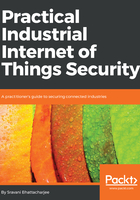
Autonomy and scalability
In enterprise IT networks, the endpoints (laptops, mobile devices, and so on) may be identified by a corporate credential tied to an employee (such as username and password, token, or biometrics). In the autonomous M2M world, device endpoints must be fingerprinted by means that do not require human interaction. Such identifiers include radio-frequency identification (RFID), symmetric keys, X.509 certificates, or a public key burned in the silicon fuses of hardware-based root of trust.
Scalability is another key consideration, as the number of endpoints in any deployment can typically be in the order of thousands to millions. Strong password-based authentication techniques, which are prevalent in IT, may not be suitable in such cases, and we may need to explore passwordless alternatives and key-based authentication. The M2M world is not so conducive to passwords, anyway.